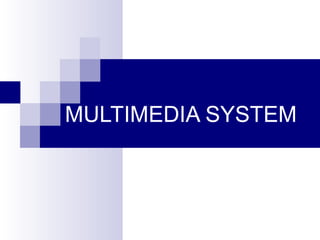
Chapter 5 The Addie Model
- 2. INTRODUCTION Multimedia system comprises of combination from elements such as texts, graphics, animation, sounds and videos to present the information to consumers through computers. Usually, not all of the elements are used but mostly just two or three elements that were deemed appropriate, which was determined by the content which was to be presented. For example, the audio element is not suitable if the courseware is for the deaf.
- 3. TYPES OF MULTIMEDIA Text Graphics Video Animation Audio Hypermedia
- 4. TEXT Text is the most important thing in a presentation. It can usually be imported from text documents which has the .txt or .doc extension. It is commonly known that texts on the screen are much harder to look at, so you would have to be aware to not put too much information on one screen.
- 5. GRAPHICS Graphics can be referred to photos, charts, graphs, etc, that is used to present information that would take too much space if the text versions were used. It can be obtained from drawing it ourselves, using scanned and pre- made graphics, and taking photos with digital cameras. There are basically two types of graphics: 2 dimensional (2D) graphics and 3 dimensional (3D) graphics. Digitalized graphics have the extension as follows: .jpg, .tiff, .gif, etc.
- 6. VIDEO Digital video clips can be integrated into your multimedia courseware. It’s unique because it can be used to show the real situation. Furthermore, digital video clips are better than analog video clips because it can replay on its own. Digitalized video clips have the following extension: .avi, .mov, etc.
- 7. ANIMATION Animation refers to the use of multiple moving images to present information. It has the ability to make the presentation more systematic. Animation can be build by using animation-making software and digitalized animation has the following extension: .avi, .flc, .dir, .mov, etc.
- 8. AUDIO Usually, audios are used to play music or special effects in the multimedia courseware. Like a video, audio have to be digitalized to change the format and it has the following extensions: .wav, .aiff, .pcm, .swa, .ram, etc
- 9. HYPERMEDIA Hypermedia refers to non-linear hyperlinks. E.g. photos can be clicked to bring users to another pop-up window.
- 10. THE PROCESS OF DESIGNING SYSTEMATIC TEACHING
- 11. Introduction The ADDIE model is the generic process traditionally used by instructional designers and training developers. The five phases—Analysis, Design, Development, Implementation, and Evaluation—represent a dynamic, flexible guideline for building effective training and performance support tools.
- 12. THE ADDIE MODEL
- 13. THE ADDIE MODEL ANALYSIS DESIGN DEVELOPMENT IMPLEMENTATION EVALUATION
- 14. ANALYSIS Analysis on the students Analysis on the learning environment Analysis on teaching content and intended outcome after the teaching process Analysis on teaching aims
- 15. ANALYSIS Analysis on the students Identify previous knowledge that the students have Students’ particulars such as age, sex, level in learning and also the students’ socio- economic status.
- 16. ANALYSIS Identify students’ learning style. There are some who find it easy to understand a new concept if given visual aids, some who like working in groups and some who like working individually. The teacher’s teaching strategies must accommodate every student in the class.
- 17. ANALYSIS Analysis on the learning environment The environment where learning takes place has a big implication in determining the preparation of teaching tools. Resources that are available in school or some organization such as: tools, cost, time and expertise will determine the method of presentation, time and place of learning.
- 18. ANALYSIS Analysis on teaching content and intended outcome after the teaching process Intended outcomes on students’ behaviours can be determined and analysed after a teaching and learning session has finished. Usually, this is done through observation at a working place such as in school, or in organization where ex-students work after finishing their studies, or doing an interview with them.
- 19. ANALYSIS Analysis on teaching aims Determine what the students have to know when they have finished learning. Teaching aims can be recognized based on difficulties that the students might encounter during previous learning process. previous analysis done by others researchers or based on other needs.
- 20. DESIGN Forming specific objectives for teaching Using the information gathered from the analysis, you must come up with specific objectives (focusing on behavioural outcome) for the students after they have finished their lesson. Test items Questions used to test the students must follow the specific objectives that had been set based on the analysis earlier.
- 21. DESIGN Choosing teaching strategies There are various teaching strategies that are commonly used in systematic teaching based on situation and learners. Some of them are: drilling, tutorial, games and simulation.
- 22. DEVELOPMENT Preparation of teaching materials Teaching materials would be prepared in stages. Visual designs and message designs have to be taken into consideration based on the chosen materials or medium.
- 23. IMPLEMENTATION Implementation of the teaching process This is the stage where teaching takes places. Teaching strategies and process are presented to the students based on the organization that had been done previously.
- 24. EVALUATION Formative evaluation Information for this type of evaluation is collected while going through each of the stages to further improve the teaching and learning process. In order to avoid from having a big problem that can only be detected after a programme had been developed. It cuts on cost and time. Done through interviews, observation and commentary from experts.
- 25. EVALUATION Summative Evaluation This type of evaluation is done towards the end of the teaching and learning process to evaluate and make any necessary changes for the next session of teaching and learning. Usually, it’s done through questionnaires.
- 26. THE ASSURE MODEL
